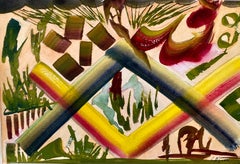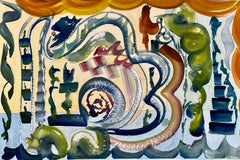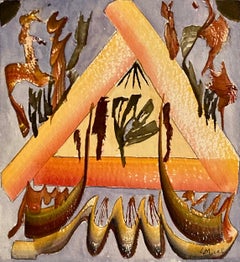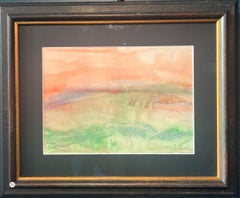Lisa Miceli Art
American
Lisa Miceli is a studio and plein air painter who teaches studio and plein air painting at the Mystic Museum of Art, Lyme Art Association, Avondale Arts in Rhode Island, and on Fishers Island, New York. Lisa is-co chair of the New England Watercolor Society “Brushes with Nature” plein air painting program, and is a member of the Noank 9 plein air painting group. Lisa’s works hang in galleries throughout New England including Arnould Gallery in Marblehead, MA, the Plymouth Center for the Arts in Plymouth, MA, Mystic Museum of Art, Lyme Art Association in Old Lyme, CT, Thames River Gallery in New London, CT, Avondale Arts in Rhode Island, and the Bryan Memorial Gallery in VT. She is currently featured in a 3-person show "Points of View" at Thames River Gallery in New London, and had a solo watercolor Show at Studio 33 Gallery in New London in 2020. Recent juried shows include the New England Watercolor Society North American Open Juried Exhibition in Plymouth, MA, the NEWs Brushes with Nature plein air show and Instructors Show, the Connecticut Plein Air Painters Society Juried Members Exhibition, the CT River Museum “Hands on the Land” show, and juried shows at Connecticut Academy of Fine Arts, Lyme Art Association in Old Lyme, CT and the Mystic Museum of Art. Her work can be viewed on her website at https://www.lmiceliart.com.
Lisa’s abstract expressionist painting “How the World Opened” was awarded the Pamela J Nelson Watercolor Award by Patricia Hickson, Emily Hall Tremaine curator of Contemporary art at the Wadsworth Atheneum Museum of Art, and Lisa was winner of the 2020 JMW Turner watercolor competition at the Mystic Seaport Museum.
Lisa studied watercolor painting with British watercolorist Ron Ranson, with Bob Noreika at the Lyme Art Association, Howard Park at the Mystic Museum of Art, and with instructors at Granite Street Gallery in New London. A significant influence on her painting was her grandmother, Lucille Gauthier who was an illustrator, watercolorist, and a WPA artist. Lisa has a doctorate in clinical psychology and her previous work as a clinical psychologist and trauma therapist has influenced her appreciation of the human condition which is integral to her art.to
4
3
1
1
Overall Width
to
Overall Height
to
5
5
4
1
5
5
4
5
8,780
2,809
1,654
1,312
1
4
5
Artist: Lisa Miceli
'Within, ' by Lisa Miceli, Watercolor Painting
By Lisa Miceli
Located in Oklahoma City, OK
This 10" x 11" watercolor on paper painting by Lisa Miceli depicts an imaginative abstracted landscape and is part of the latticeWorks series. The use of c...
Category
2010s Abstract Lisa Miceli Art
Materials
Watercolor, Paper
$480 Sale Price
33% Off
'Traveling' by Lisa Miceli, Watercolor Painting
By Lisa Miceli
Located in Oklahoma City, OK
This 11" x 15" watercolor painting is by New England artist, Lisa Miceli. This painting is part of the Lattice Works series. The use of color and compositional elements in this seri...
Category
2010s Abstract Lisa Miceli Art
Materials
Watercolor
'Where Hummingbirds Swim, ' by Lisa Miceli, Watercolor on Paper Painting
By Lisa Miceli
Located in Oklahoma City, OK
This framed 27" x 14" watercolor on paper by artist Lisa Miceli depicts the abstracted movement of birds, figures, and aquatic imagery that the artist uses...
Category
2010s Abstract Lisa Miceli Art
Materials
Watercolor, Paper
$1,280 Sale Price
33% Off
'Submerging, ' by Lisa Miceli, Watercolor on Paper Painting
By Lisa Miceli
Located in Oklahoma City, OK
This 15" x 22" watercolor on paper painting by Lisa Miceli depicts an imaginative abstracted landscape. This painting is part of the "latticeWorks Series."...
Category
2010s Abstract Lisa Miceli Art
Materials
Watercolor, Paper
$960 Sale Price
33% Off
'The Hearth, ' by Lisa Miceli, Watercolor Painting
By Lisa Miceli
Located in Oklahoma City, OK
This 10" x 11" watercolor on paper painting by Lisa Miceli depicts an imaginative abstracted landscape suggestive of a warm hearth setting. This painting i...
Category
2010s Abstract Lisa Miceli Art
Materials
Watercolor, Paper
$560 Sale Price
33% Off
Related Items
'Sunset Landscape', Hamburg, Rivne, Volhynia, Rivne Museum
Located in Santa Cruz, CA
Signed lower right, 'G. Kosmiadi' for Georg Kosmiadi (Ukranian-German, 1886-1967) and dated, '66'; additionally signed verso, 'Georg Kosmiadi', inscribed with serial number and dated, '20/9/66'.
Georg Kosmiadi was a resident of Rivne before moving to Hamburg in 1940 where he worked as an art teacher. Kosmiadi exhibited at the Rivne Regional Museum and a regional art...
Category
1960s Abstract Impressionist Lisa Miceli Art
Materials
Paper, Gouache
$2,750
H 13 in W 18.25 in
"Landscape at sunset-Luberon-France" Watercolor , cm. 29, 5 x 21 1960 ca
By Dora Maar
Located in Torino, IT
orange, green, sunset
Dora Maar is the pseudonym of Henrietta Theodora Markovitch (Paris 1907 - 1997).
Shrouded in the monumental shadow of Picasso, she has long been - and reductive...
Category
1960s Abstract Expressionist Lisa Miceli Art
Materials
Paper, Watercolor
$11,914
H 14.57 in W 18.51 in
Original-Golden Summer-UK Awarded Artist, British School, Exhibition Collection
Located in London, GB
Shizico spent three days painting this plein air in her sunlit garden. She applied 550 Ture Gold paint and Van Gogh Yellow creating a stunning backdrop which served as the canvas for...
Category
2010s Abstract Expressionist Lisa Miceli Art
Materials
Gold
$618
H 16.54 in W 11.82 in D 0.04 in
Sumac, colorful Abstract Impressionist landscape gouache
By Sandy Litchfield
Located in New York, NY
Sandy Litchfield found peace and inspiration in regular solitary walks through nature throughout the pandemic. Her most recent body of work diaristically documents her constitutional...
Category
2010s Abstract Impressionist Lisa Miceli Art
Materials
Paper, Gouache
Large Ink Drawing Abstract Expressionist Rooster Woman Artist Judith Brown
By Judith Brown
Located in Surfside, FL
Judith Brown (December 17, 1931 – May 11, 1992) was a dancer and a sculptor who was drawn to images of the body in motion and its effect on the cloth surrounding it. She welded crushed automobile scrap metal into energetic moving torsos, horses, and flying draperies.
Brown attended Sarah Lawrence College in Yonkers, New York (B.A., 1954), where she learned to weld from her teacher, Theodore Roszak, a pioneering abstract expressionist sculptor. This is done in a style similar to Leonard Baskin.
Select Commissions
Mural Sculpture, Lobby, Louisville Radio Station WAVE
Fountain, commissioned by Architectural Interiors, New York City
Model, designed and executed for Festival of Two Worlds, Spoleto, Italy
Sculpture, designed for Electra Film Productions, NYC
Noah's Ark, exhibited at Bronx Zoo, New York City, at Rochester Museum and Science Center, Rochester, New York, and at Hopkins Center, Hanover, New Hampshire
Store Windows, executed Tiffany & Company Windows, New York City, Christmas 1957, 1959, 1962, October 1969, Spring 1979, and October 1980
Wall Sculptures: for Youngstown Research Center (1963-4), commissioned by Youngstown Steel Company, Youngstown, Ohio; for Hecht and Company, Landmark Shopping Center, Alexandria, Virginia, Daniel Schwartzman, Architect; for Lobby, 570 Seventh Avenue, New York City, Giorgio Cavaglieri, Architect; for Lobby, Cities Service Company's New Research Center, Cranbury, New Jersey; for Ottauquechee Health Center, Woodstock, Vermont
Eternal Lights: for Congregation Beth-El, South Orange, New Jersey; for Congregation Sharey Tefilo, East Orange, New Jersey
Menorahs: commissioned by Architect Fritz Nathan for the Permanent Collection of the Jewish Museum, New York City; commissioned by Smith College for the Helen Hill Chapel, Northampton, Massachusetts; commissioned by Jules Scherman, of Wisteria Press, Inc., New York City
Altar Cross, commissioned by Smith College for the Helen Hill Chapel, Northampton, Massachusetts
Landscape, Memorial Piece for Gustave Heller, YM-YWCA, Essex County, New Jersey
Memorial Plaque for Robert A. Ferguson, Westchester County Airport, Purchase, New York
Sculpture for Vice President's office, Atlantic Richfield Company, New York City
Bronze Relief Sculpture for Gymnasium Lobby, South Richmond High School, Staten Island, New York, Daniel Schwartzman, Architect
Poster, Stratton Arts Festival, Stratton, Vermont
Medallion, commissioned by Brandeis University National Women's Committee, New York City
Model for Fountain for the Plaza at Windsor, Vermont
Bronze Sculpture, commissioned by Intramural, Inc. for Building Lobby, N/E Cor. 79th Street and Second Avenue, New York City
Presentation Piece, commissioned by Graphic Arts Associates of Delaware Valley, Philadelphia, Pennsylvania
Wall Mural, Noah's Ark, Roosevelt Hospital, New York City
1977: Designed and executed Hanes Hosiery "Million Dollar Award"; Designed and executed "Old Spice" Smart Ship Award
1978: Commissioned to design and execute the "Walter White Award" for the NAACP for presentation to Hubert Humphrey; Commissioned to design and execute the Award for the Honorees of the National Board YWCA's First Tribute to Women in International Industry
1979: Designed and executed Jewelry for the Museum of Modern Art, New York City; Designed and executed limited edition of Mazuzas for Brandeis University-National Women's Committee, New York City
1980: Bronze Cross commissioned for St. James Episcopal Church, Woodstock, Vermont
1982: Eubie Award, New York Chapter of the National Academy of Recording Arts and Sciences
1985: Two Sculptures, Marriott Hotel, Orlando, Florida
1986: Two large Sculptures for indoor reflecting pools, Palm Desert Hotel, Palm Springs, California; John Portman, Eight Sculptures for Peachtree Plaza Hotel, Atlanta, Georgia; John Portman, Beach House, Sea Island, Georgia
1987: Loan Installation, DeCordova Museum, Lincoln, Massachusetts
1988: Eleven foot outdoor Sculpture for Front Plaza, River Court, Charles River, East Cambridge, Massachusetts, H. J. Davis Development Corp.; Tomie dePaola...
Category
1950s Abstract Expressionist Lisa Miceli Art
Materials
India Ink, Handmade Paper
$1,200
H 30.5 in W 22.25 in
Abstract Watercolor Painting, 'Design for Sculpture', C. 2000 by David Ruth
By David Ruth
Located in Oakland, CA
This is a contemporary abstract watercolor painting by artist David Ruth. This series of paintings often feature bright colors and vibrant layouts that draw the viewer in. They are c...
Category
Early 2000s Abstract Expressionist Lisa Miceli Art
Materials
Paper, Watercolor
Abstract Watercolor N.8 by Dmitry Samygin
By Dmitry Samygin
Located in Paris, FR
Abstract Watercolor N.8 by Dmitry Samygin
Minimalist and geometric paintings.
Technique: Watercolor
Color: Teal blue
Size: H. 35.5 x 27.5 x 0.1 cm
Dmitry Samygin is a Furniture a...
Category
21st Century and Contemporary Abstract Geometric Lisa Miceli Art
Materials
Watercolor
"Chimneys at Dusk", Small Pastel San Francisco Abstract Urban Landscape
Located in Soquel, CA
Abstracted Bay Area skyline against a pink sunset creates beautiful and soft geometries in this small pastel urban landscape by San Francisco artist Chris...
Category
1990s Abstract Impressionist Lisa Miceli Art
Materials
Paper, Pastel, Watercolor
$650
H 16.5 in W 17.13 in D 0.75 in
'Refracted Sunset, Coral and Ocean Blue', Seascape
By Nada Brahma
Located in Santa Cruz, CA
Lower right "N.Brahma", inscribed verso "Nada Brahma" and titled "Refracted Sunset".
A large watercolor seascape showing an abstracted view of jade and cobalt waves beneath a scarle...
Category
1980s Abstract Lisa Miceli Art
Materials
Paper, Watercolor, Graphite
Framed Early Modern Black & White Abstract Surrealistic Animal Drawing Studies
Located in Houston, TX
Early modern black and white sketch by iconic Houston based artist David Adickes. Pulled from a collection of previously undiscovered sketchbooks, this work serves as a peak behind t...
Category
Mid-20th Century Modern Lisa Miceli Art
Materials
Paper, Pencil
$1,800
H 18 in W 15 in D 1.5 in
Llangorse Lake Brecon Beacons Wales Circa 1964 Welsh Abstract Landscape Painting
By Roger Cecil
Located in Sutton Poyntz, Dorset
Roger Cecil.
Welsh ( b.1942 - d.2015 ).
Llangorse, Brecon Beacons.
Watercolor & Pastel Mixed Media On Paper.
Signed Lower Left.
Image size 19.5 inches x 29.5 inches ( 49.5cm x 75cm...
Category
Mid-20th Century Abstract Expressionist Lisa Miceli Art
Materials
Paper, Pastel, Watercolor
$4,806
H 24.61 in W 34.65 in D 0.99 in
"Lascaux" Mid-20th Century American Abstract 1960s Color Field Modernist
Located in New York, NY
"Abstraction" Mid-20th Century American Abstract 1960s Color Field Modernist
James Daugherty (1887-1974)
"Lascaux"
5 ¼ x 8 ¼ inches
Pastel on paper
Initialed lower left, titled lo...
Category
1960s Abstract Lisa Miceli Art
Materials
Paper, Pastel
Lisa Miceli art for sale on 1stDibs.
Find a wide variety of authentic Lisa Miceli art available for sale on 1stDibs. If you’re browsing the collection of art to introduce a pop of color in a neutral corner of your living room or bedroom, you can find work that includes elements of orange and other colors. You can also browse by medium to find art by Lisa Miceli in paint, paper, watercolor and more. Much of the original work by this artist or collective was created during the 21st century and contemporary and is mostly associated with the abstract style. Not every interior allows for large Lisa Miceli art, so small editions measuring 11 inches across are available. Lisa Miceli art prices can differ depending upon medium, time period and other attributes. On 1stDibs, the price for these items starts at $600 and tops out at $1,600, while the average work can sell for $950.






